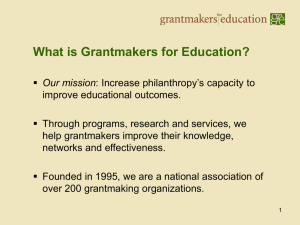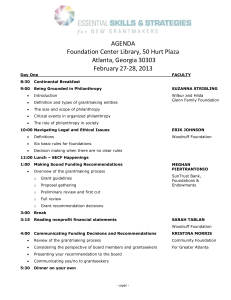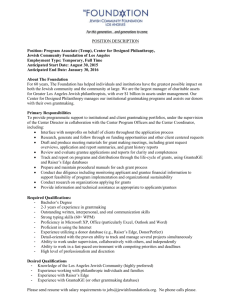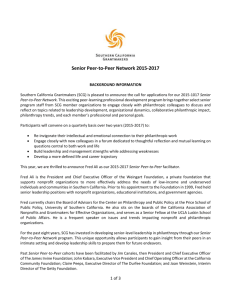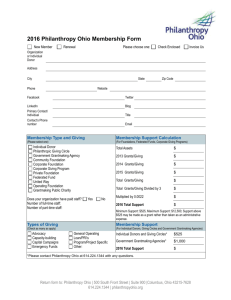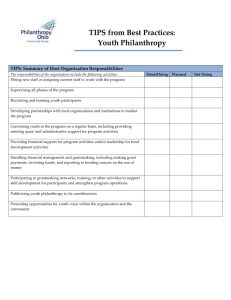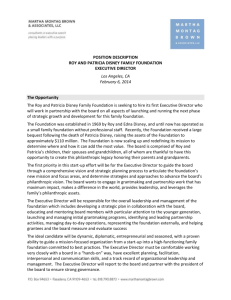The State of Philanthropy
advertisement
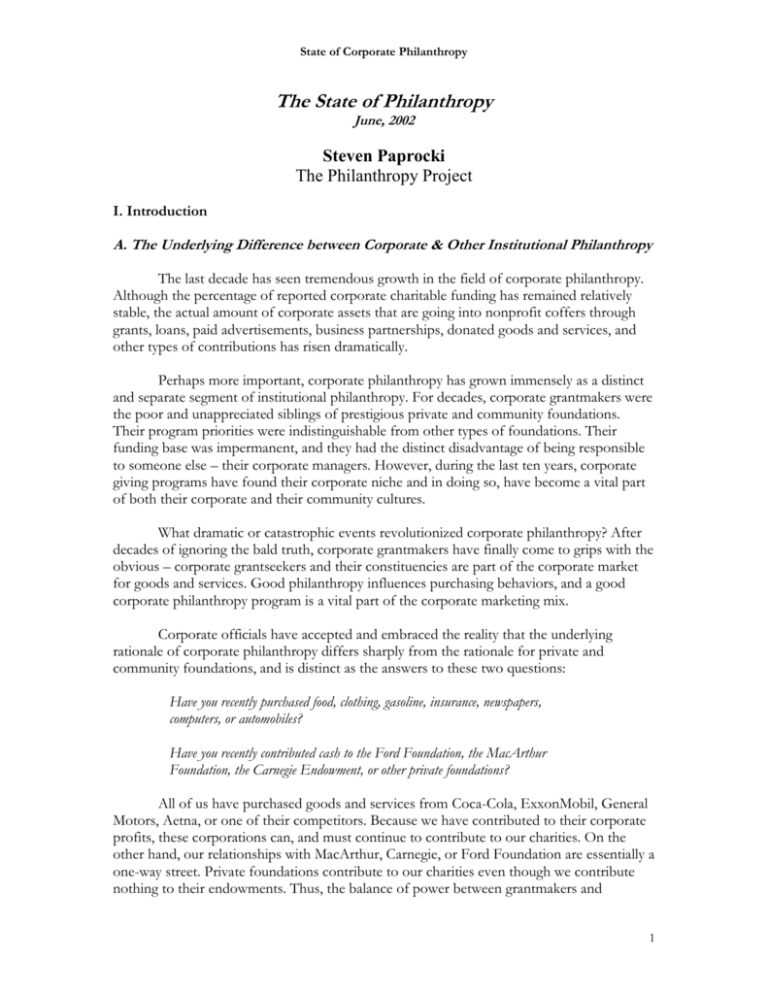
State of Corporate Philanthropy The State of Philanthropy June, 2002 Steven Paprocki The Philanthropy Project I. Introduction A. The Underlying Difference between Corporate & Other Institutional Philanthropy The last decade has seen tremendous growth in the field of corporate philanthropy. Although the percentage of reported corporate charitable funding has remained relatively stable, the actual amount of corporate assets that are going into nonprofit coffers through grants, loans, paid advertisements, business partnerships, donated goods and services, and other types of contributions has risen dramatically. Perhaps more important, corporate philanthropy has grown immensely as a distinct and separate segment of institutional philanthropy. For decades, corporate grantmakers were the poor and unappreciated siblings of prestigious private and community foundations. Their program priorities were indistinguishable from other types of foundations. Their funding base was impermanent, and they had the distinct disadvantage of being responsible to someone else – their corporate managers. However, during the last ten years, corporate giving programs have found their corporate niche and in doing so, have become a vital part of both their corporate and their community cultures. What dramatic or catastrophic events revolutionized corporate philanthropy? After decades of ignoring the bald truth, corporate grantmakers have finally come to grips with the obvious – corporate grantseekers and their constituencies are part of the corporate market for goods and services. Good philanthropy influences purchasing behaviors, and a good corporate philanthropy program is a vital part of the corporate marketing mix. Corporate officials have accepted and embraced the reality that the underlying rationale of corporate philanthropy differs sharply from the rationale for private and community foundations, and is distinct as the answers to these two questions: Have you recently purchased food, clothing, gasoline, insurance, newspapers, computers, or automobiles? Have you recently contributed cash to the Ford Foundation, the MacArthur Foundation, the Carnegie Endowment, or other private foundations? All of us have purchased goods and services from Coca-Cola, ExxonMobil, General Motors, Aetna, or one of their competitors. Because we have contributed to their corporate profits, these corporations can, and must continue to contribute to our charities. On the other hand, our relationships with MacArthur, Carnegie, or Ford Foundation are essentially a one-way street. Private foundations contribute to our charities even though we contribute nothing to their endowments. Thus, the balance of power between grantmakers and 1 State of Corporate Philanthropy grantseekers in a corporate philanthropy setting is much more equitable than similar relationships in private foundations. We should note that besides the rationale, there is another major difference between corporate philanthropy and private foundations: accountability to core constituents. Once the corporate philanthropic entity has been established and its giving levels are determined, corporate donors are generally more responsive to the charitable needs of their specific constituents – employees, stockholders, neighbors, and primary consumers. On the other hand, tax and legal commitments aside, private foundations have no underlying obligation to be responsive to a community or core constituencies. Indisputably, private foundation leaders are sensitive to changing community needs, but their continued existence from year-to-year is hardly reliant upon their ability to adapt programs, priorities, and procedures to the changing needs of these stakeholders. The effect of these differences has been good for society. The market accountability of corporate giving programs makes these programs much more vibrant, sensitive, and creative in response to changing community needs. This responsiveness has resulted in several innovations in priorities, procedures, and types of giving programs. However, without obligation to core constituencies, private foundations are free to establish independent programs and process and to take risks without fear of retribution. Their ability to nourish high-risk projects has resulted in the development of many worthwhile and successful social and cultural prototypes. At the same time, private foundations also have the freedom to support sorely needed ongoing programs, such as shelters and rehabilitation programs that may not have the pizzazz or popularity to generate continuing public support. B. The New Corporate Philanthropy Along with their increased visibility, corporate philanthropic programs have become more accountable. Because Chief Executive Officers (CEO) insist these giving programs be as responsible for corporate profits as other corporate divisions, community relations and corporate giving programs have broken out of the traditional philanthropic molds. These re-born corporate-community relations programs reinvented themselves in a style dramatically different from their counterparts in other philanthropic institutions. The reinvention is evident in almost every facet of giving – the total worth of contributions and transfers, types of giving programs, grantmaking procedures & policies, motivation & selfperception of corporate grantmakers, and opportunities for community input. C. “Strategic Philanthropy” The common rubric for this reinvention is “strategic philanthropy,” a name that echoes the reinvention process taking place in almost every corporate boardroom, department headquarters, and regional office in America. How strategic philanthropy is 2 State of Corporate Philanthropy applied within a corporation depends, of course, on the individual corporation, however strategic philanthropic planning often results in six common adaptations: The philanthropic mission and grantmaking programs are refocused to accentuate those aspects of grantmaking that most clearly benefit the corporation and its stakeholders. To this end, corporate grantmakers are expected to design and evaluate themselves against concrete measurable objectives that benefit the corporation, such as media “hits” generated by corporate grantmaking programs or the number of contacts with potential new employees. Corporate grantmaking job descriptions are repositioned to focus more time and energy on internal responsibilities. New corporate grantmaking staffs often view their primary function as internal resource people, providing valuable information and feedback on community issues to management and other corporate departments. While giving priorities are often narrowed, sometimes to just one or two types of recipients or programs, grantmaking decision-making becomes highly decentralized to allow much more input or control by employees, shareholders, and even consumers. The type and number of grantmaking and community relations programs are expanded and diversified to broaden outreach to key constituencies and to increase employee participation in community activities. A corporate grantmaking “Signature Program” is adopted which provides a highconcept focus for the corporation’s grantmaking and community relations programs. II. Major Changes in Corporate Philanthropy A. The Constant: The Motivation for Corporate Philanthropy While there are several motivations for corporate grantmaking programs, including community enhancement, corporate marketing, investment protection, improved relations with interest groups or government agencies, and perhaps even simple, unadulterated corporate altruism, former Citibank president William Spencer argues that one underlying motivation remains constant and clear: Like any other investment we make, corporate contributions must meet the test of being in the long-term self-interest of the corporation and its shareholders. To disguise this ultimate standard would be neither believable nor accurate 1 3 State of Corporate Philanthropy While the underlying motivation for corporate philanthropy may be clear, the definition of corporate self-interest is the subject of ongoing debate. Very few corporate managers still expect a straight-line relationship between a specific grant and increased shareholder value. However, many corporate leaders do believe that corporate grantmaking exists primarily to support their personal interests or to primarily support the company’s sales function. Some veteran grantmakers talk quietly about occasionally awarding “BHSA grants,” that is “blatantly hypocritical, sullenly acquiescent.” While some of these grants still exist, among most corporate grantmakers, grantmaking that is independent of strong-arming by sales and marketing forces is a point of personal pride and a sign of professional sophistication. For the most part, corporate managers and grantmakers believe in the concept of “enlightened self-interest,” that is, in the end, corporate interests are best served by assisting others in meeting their goals. For example, one manufacturer saved more than $40,000,000 in plant relocation costs by awarding several thousand dollars in grants to a neighborhood revitalization program that eventually resuscitated the inner city neighborhood where the old plant was located. This investment may not have increased actual sales, but the effect on the corporation’s bottom line – the costs of moving a plant from an inner city neighborhood to the suburbs – was nevertheless positive. Additionally, the corporation continues to receive national and local goodwill from its relatively small philanthropic investments in the neighborhood group and the company’s abiding faith in its inner city neighbors. B. The Changes: the Amount, the Types, the Procedures & Opportunities for Community Input 1. Total Amount of Corporate Contributions and Transfers a. What’s Reported and Not Reported The amount of money and assets that corporations transfer to nonprofits, government institutions, colleges, and other not-for-profit entities is enormous and the variety of forms is just as amazing. Reports from research institutes and trade associations such as the Foundation Center, the American Association of Fund Raising Counsel (AAFRC), and the Council for Aid to Education (CFAE) indicate annual corporate giving is typically in the $8 to $9 billion range2. While these estimates may be accurate within specific research parameters, as an accurate representation of all corporate giving these data are extremely incomplete. Typically, these giving reports do not include the amounts contributed by corporations in: (a) matching gift programs, (b) in-kind contributions, (c) employeevolunteer release time, (d) cost of internal fundraising drives (e.g., for United Way), (e) temporary contributions of space and equipment, (f) non-domestic cash gifts (international subsidiaries), contributed advertising, (g) fundraising sponsorships, (h) cost of corporate giving program administration and (i) the newest and most lucrative source of corporate4 State of Corporate Philanthropy community financial arrangements: cause-related marketing relationships (CRMs) with notfor-profit entities. Added together with the $8 billion to $9 billion already reported, these unreported and under-reported corporate contributions and transfers total between $40 billion and $50 billion per year, twice the amount from all other private and community foundations. b. The Problems of Unreported and Under-reported Funding Many of these asset transfers to nonprofit organizations, especially cause-related marketing, are not reported as charitable contributions, but rather as business expenses. Several other arrangements, such as contributed advertising, are gray-area philanthropy, that is, the benefit to the donor equals or slightly exceeds the benefit to the recipient. All of these business expenses and gray area philanthropy are income that accrue to a charitable organization and yet, they are not included in corporate charitable giving reports. To exclude these financial arrangements from reports of corporate giving is naïve, since all corporate giving – whether it is legally reported as a charitable contribution or a business expense – is in fact a business expense of the donor corporation. What’s the difference? Take for example XYZ Inc.’s $10,000 gift to ABC Charity. If XYZ Inc. awards a $10,000 gift through its foundation; it must divulge all the pertinent details of the gift as a charitable contribution. On the other hand, if XYZ Inc considers the same gift to ABC Charity to be a business expense; it is not required to publicly report the donation. To require public reports of so-called charitable contributions while excluding identical business expenses from corporate giving reports encourages a double standard of accountability and discourages the establishment of corporate-sponsored foundations. Additionally, under-reporting of corporate giving and corporate financial arrangements with America’s charities diminishes the public’s understanding of the important role these corporate contributions and financial arrangements. Corporate gifts and financial arrangements constitute a majority of the annual funding for many of America’s charities, including such public policy advocates as the NAACP, AARP, and the Nature Conservancy. To under-count, under-estimate, or simply ignore the total amount of corporate gifts to, and financial arrangements with America’s nonprofits is akin to ignoring the crucial role that corporate political action committees play in American political life. Although annual research reports indicate corporate donations equal just half the amount awarded by private and community foundations, the breadth and role of corporate financing for America’s not-for-profit entities is incredible. For example: Income from corporate sources comprises an estimated two-thirds of the annual budgets of the top ten U.S. civil rights organizations. 5 State of Corporate Philanthropy More than 40% of non-government contributions for community development corporations come from corporate gifts and other financial arrangements. According to one veteran corporate giving watcher, nearly eighty percent of nongovernment contributions to public schools is derived from corporate contributions of cash, goods, contributed employee time, sponsorships, and cause-related marketing arrangements (including CRMs that return a small percentage of a consumer’s purchases to the consumer’s favorite school). 2. Types of Giving Programs In general, there are three types of corporate philanthropy: (1) direct contributions, that is gifts of cash or goods awarded directly from corporate operating budgets, (2) company sponsored foundation gifts, and (3) “corporate assistance”, that is, indirect support such as sponsorship events, contributed employee-time, and in-house workplace giving drives. The lines between these three types of support have blurred so much during the past decade that attempts to ascribe contribution levels to each program is fruitless. Overall, corporate philanthropy financial totals and distinctions are important only to those who approach corporations for different types of support. Grantseekers need accurate information on the total amount awarded by the corporation’s grantmaking program but may need very little information on the company’s in-kind or sponsorship programs. Within this new taxonomy, there are several types of corporate philanthropy: grants, in-kind contributions, employee-initiated giving, consumer-initiated giving, employee-volunteer programs, contributed sponsorships a. Expanded Programs Along with the amount of corporate giving, the variety of corporate giving programs has grown tremendously during the last decade. In addition to the traditional programs – standard grantmaking programs, fundraising sponsorships, workplace giving campaigns, and matching gift programs for higher education – corporate giving now comes in hundreds of forms, including several new or expanded giving programs such as: New employee volunteer time and volunteer-based grant programs (such as “dollars for doers”, mentoring programs, and “community volunteer days”), New consumer purchase matching and cause-related marketing programs, Expanded workplace giving options (such as workplace campaigns for the National Black United Fund, environmental causes, and women’s funds), New employee matching options, (including matching gifts for arts, cultural, community, K-12 education, and environmental programs), In-kind contributions of almost everything that a company purchases or makes, New corporate scholarship and internship programs (including overseas programs and summer job-post graduation work programs) 6 State of Corporate Philanthropy New and expanded grantmaking programs (including funding pools for nonheadquarters plant communities, employee-controlled charitable giving programs, and special funding programs for specific causes, such as hunger or homelessness. b. Cause-Related Marketing The most prominent new features in the world of corporate-community financial arrangements are a wide variety of sales-based agreements known as cause-related marketing relationships. These marketing programs tie corporate contributions and fees to charityrelated corporate sales. Generally, the cooperating charity receives a pre-determined amount from the cooperating corporation for every sale or sales opportunity the corporation receives as a result of its relationship with the charity. For example, when Special Olympics telemarketers sell magazine subscriptions for Time magazine, the company awards the charity with 12½ % of the subscription price. Several respected fundraising and development associations condemn these relationships as organizationally dangerous and marginally ethical, but CRMs generate nearly $20 billion annually nonprofits and have changed the face of fundraising forever. Some national nonprofits derive more income from these relationships than from all other grantseeking efforts. Many nonprofits, even small, local groups have generated long-term income-streams via creative sales-generating marketing strategies, such as affinity credit cards, special store nights during which a percentage of sales are contributed to cooperating charities, and a pre-set contribution for every customer referred by a cooperating charity. c. Signature Programs Perhaps the most popular new corporate giving program, from a corporate perspective is the Signature Program, a special interest area, and charitable giving program to which a corporation attaches special importance. A signature program, which may take years to develop, typically results in additional corporate funding and staff, a proactive programming role, a time commitment from the CEO and senior management, and most important, a prominent role in the corporation’s advertising and public relations efforts. Texaco’s commitment to the Metropolitan Opera and American Express Inc.’s commitments, first to the Statue of Liberty and then to the hunger relief program, Share Our Strength, were the first nationally prominent corporate signature programs. Now, more than 150 of Fortune 500 companies have special commitments to special causes that they view as unique charitable ventures that are (a) popular among their stakeholders, (b) consistent with their corporate mission, and (c) present a ripe opportunity to make a sizeable impact in an important charitable endeavor. Home Depot’s commitment to home ownership, Apple Computer’s commitment to conquering the digital divide, and Reader’s Digest commitment to literacy are just a few of the hundreds of signature programs that major corporations have and are developing. Signature programs do indeed offer great humanitarian opportunities in very specific areas of charitable endeavor. They also provide great marketing opportunities and wonderful 7 State of Corporate Philanthropy junctures for collaboration between diverse corporate shareholders. However, when signature programs monopolize the majority of corporate giving time, money, and attention, other worthwhile charities outside of the signature program’s focus area go wanting for corporate support. This can be especially devastating for smaller, geographically limited organizations that have few potential corporate donors within their service areas. d. The Problems with Diversified Corporate Support “Portals” Unlike most private and community foundations, corporate grantmaking programs are not “one-stop-shops” for those seeking corporate financial support. Several companies, such as Target Corporation, Chase Manhattan Bank, ExxonMobil, and McDonald’s have literally hundreds of portals where individual fundraisers can apply for money or ask for different types of support. Even within a single store or office of a major corporate headquarters or regional office, there are typically dozens of places to apply for different types of support. One office or individual handles grants, another works with matching gift programs, but another department or individual usually manages employee volunteer programs. Sponsorships and CRMs are typically not administered by grantmakers and several individuals in several different locations may be responsible for in-kind contributions. While the diversity of these programs and multitude of program managers increases access to nonprofits, the breadth of these programs can be overwhelming for even a sophisticated corporate support seeker. 3. Grantmaking Procedures & Policies Corporate grantmakers have made four important changes in the area of grantmaking procedures and policies: a. Decentralized Decision-Making The success of a corporate grantmaking program is largely dependent on the commitment of the corporate CEO and senior management. Academic studies indicate that three-fourths of corporate CEOs play a “major” role in setting the goals and budgets for corporate grantmaking programs. Other studies indicate the increased level of CEO involvement in corporate grantmaking correlates positively to the success of the program. Almost all successful corporate grantmakers credit the support of their CEO and senior management team for their achievements (on the other hand, corporate grantmakers without supportive bosses rarely attend corporate grantmaking conferences or talk about the success or failures of their programs, so the role of CEOS may be slightly over-played). Overall, corporate giving and community volunteers programs are now largely influenced, and occasionally even controlled by corporate employees. Employee committees, plant managers, employee matching gift programs for both cash and time contributions, shareholder input, community nominations, and special advisory committees for grants for 8 State of Corporate Philanthropy Racial and Ethnic communities, women’s groups, and other special population groups are just a few of the means used by corporations to decentralize corporate decision-making. b. Accelerated Decision-Making Until recently, grantmaking decisions by corporate contributions officers often required from several months to a year to award or reject grant applications. This lengthy turn-around time discouraged grant requests from smaller, less conventional nonprofits and diminished the grantmaker’s ability to respond to community needs in a timely manner. However, during the last few years, corporate grantmakers have greatly decreased the time required to turn-around a grant request. On-line application procedures, localized decision-making procedures, and clearly defined grantmaking priorities have shortened corporate grantmaking procedures to as little as one week’s consideration. Visit Texaco’s grantmaking homepage or bellatlanticfoundation.com to witness paperless applications, the future of professional grantmaking. c. Donor-Related Questions and Benefits Corporate donors are becoming increasingly candid about the relationship between corporate benefits and corporate grantmaking. Although many corporate donors are still shy about drawing a straight line between profits and funding opportunities, many corporate grantmakers now ask how an applicant’s funding proposal will benefit corporate employees or other corporate interests. Some corporate grantmakers now ask applicants how; if they are funded, recipients intend to publicize the grant and how the recipient will publicly and prominently honor the corporate donor. Other grantmakers insist that potential grantees offer the potential donor a range of options by which the donor wishes to be honored. Some college grantseekers must signify in writing that potential donors will be allowed to recruit employees on campus if the corporate grant is awarded. While this is not typically a burdensome promise, for some controversial companies (such as tobacco manufacturers, companies with poor minority hiring records or in earlier times, defense contractors) some colleges would prefer to keep their options open. d. Well-Defined Grantmaking Criteria and Priorities In addition to changes in grantmaking procedures, corporate grantmakers have further streamlined their grantmaking timelines by increasingly refining and narrowing their corporate giving program priorities. Corporate grantmaking restraints were once limited to a few broad exclusions, such as “funding only in corporate headquarters”, “no general operating grants for United Way agencies”, and “giving only for education”. Increasingly, corporate giving limitations are very specific, such as “grantmaking only for K-12 earth science education,” “grantmaking only for pre-selected charities,” “only to charities in the corporation’s immediate service area,” and “grantmaking only to those organizations where corporate employees volunteer.” 9 State of Corporate Philanthropy While these limitations offer clear parameters and usually the unvarnished truth about corporate priorities, neighborhood organizations that have a limited geographic scope or organizations, or those with less popular concerns, such as halfway houses for exprisoners, must rely on a small number of donors 4. Opportunities for Community Input The most significant change in corporate grantmaking during the past decade is perhaps, the least obvious. While corporate grantmakers were changing their perception of their mission and function, corporate grantmakers were also changing their perception of their philanthropic consumers that is applicants and recipients of corporate philanthropy. The reasoning developed that if corporate philanthropy is, in fact, a function of corporate marketing and public relations, then applicants and recipients could no longer be treated as subservient or as supplicants to a well meaning, but condescending philanthropist. Corporate grantmakers began seeing their associations with applicants and grantees as any other market – a potential long-term partnership that could benefit both corporate and consumer interests. While corporate public relations efforts have usually included outreach to major charitable organizations and nonprofits that represent major constituency groups, such as the NAACP or the American Association of Retired Persons (AARP), the symbiotic perspective now extended to grantmaking and other corporate support functions. And with good reason. Independent surveys and studies indicated most American consumers were regularly making the connection between their favorite charitable cause and their behavior as consumers. For example: According to one consumer survey, 75% of American consumers are willing to change stores or brands to support those corporations that support their favorite charities. In other words, consumers will drive the extra mile to Wal-Mart if K-Mart does not support their favorite causes. A survey developed for fifteen States Attorneys General found that 95% of Americans believe commercial endorsements by nonprofit organizations but only 30% accept the word of for-profit corporations. When the American Cancer Society says orange juice may decrease the chances of contracting cancer, most of us believe them. However, less than one-third of us would believe this same conclusion if we heard it from the Florida Orange Growers Association. Corporate leaders are hearing this message loud and clear. More than 85% of CEOs told the Conference Board that corporate success requires good community relations. Is this commitment to good community relations just CEO braggadocio or are words being backed up with action? There is some evidence that words and action are coming together, perhaps reluctantly at first, but corporate managers are beginning to incorporate corporate philanthropy into major business decisions. 10 State of Corporate Philanthropy Philanthropy was a major point of contention during merger discussions between Ben & Jerry’s Ice Cream and Unilever, a British company that does not have a long tradition of corporate philanthropy. Eventually, Unilever committed several millions to maintain the exemplary philanthropic tradition established by the popular ice cream manufacturer. After First Union National Bank announced its takeover of Philadelphia-based CoreStates Bank, community activists caused an uproar until First Union promised to establish an independent $7 million philanthropic program specifically for the CoreStates service area. When Dart Corporation tried to takeover Minnesota-based Dayton-Hudson Company (now Target Corporation), Dayton-Hudson officials successfully rallied Minnesota nonprofit leaders to convince state legislators to pass emergency antitakeover legislation. The possible demise of Dayton-Hudson’s outstanding philanthropic program was the primary reason the state legislator acted on the company’s behalf. In an informal survey of 38 front-page or business page stories about corporate mergers appearing in the New York Times since the beginning of the year, 22 stories reference corporate philanthropy. III. Trends and Concerns A. The Effects of Mega-Mergers Probably the most serious negative impact on corporate philanthropy during the last decade has been corporate mergers. While these mergers may increase bottom line profits, they typically decrease the overall amount of funding awarded to nonprofit organizations. Paul Ostergaard, former president of the Citigroup Foundation recently told nonprofit officials “it is naive to think merged companies will continue to give the same amount that the two businesses collectively gave prior to the merger.” NCRP’s recent survey of corporate giving to Racial and Ethnic communities bears witness to Mr. Ostergaard’s statement. Forty of the 124 companies surveyed for NCRP’s Grants: Corporate Grantmaking for Racial and Ethnic Communities, have been involved in megamergers during the last five years. From follow-up conversations with company officials, NCRP estimates that corporate giving from these 40 companies decreased by $186 million as a result of these mega-mergers. Among these, several exemplary corporate grantmakers such as Exxon, Citibank, Travelers, Wells Fargo, Amoco, ARCO, and Honeywell, are reporting huge reductions in their corporate grantmaking programs. Community officials in Los Angeles, Minneapolis, Philadelphia, Chicago, and several other major metropolitan areas are beginning to publicly wonder about the devastating effects that these mergers will have on local United Way campaigns and financing for community nonprofits in general. 11 State of Corporate Philanthropy B. Continued Growth of Strategic Philanthropy There is no indication that the strategic philanthropy movement is losing steam in corporate grantmaking circles. In fact, once the exclusive domain of larger companies, smaller corporate donors are beginning to adopt some of the basic tenets of strategic philanthropy – increased concentration on the benefits to the sponsoring business, measurable business objectives, limited grantmaking priorities, more internal-looking staffing, decentralized decision-making, and adoption of a corporate signature program. While we applaud the professional development of corporate grantmaking, several funding shortfalls often result from this professionalization. There are two reasons for concerns about the impact of strategic philanthropy programs: A shortage of general operating support for a broad range of unmet community needs. Employee volunteer programs, sponsorships of major fundraising events, matching gift programs, and consumer-initiated corporate philanthropy are popular and effective corporate giving programs. However, projects that do not fall into the very specific funding categories established by corporate donors will have greater financial problems than before the development of strategic philanthropy. Smaller organizations with less popular causes or smaller geographic parameters may no longer find support in the more developed corporate grantmaking programs. More giving “portals” than manageable for smaller nonprofit organizations. Expanded giving opportunities and responsibilities are positive signs, but with limited fundraising resources, smaller organizations may become discouraged by a plethora of opportunities and application portals. C. A Continuing Problem for Constituency Controlled Organizations Corporate grantmaking to constituency-controlled organizations, that is organizations, which are owned and operated by their primary beneficiaries, remains an ongoing problem, at least for Racial and Ethnic communities. NCRP surveys of 124 corporate grantmakers in 19956-96 and telephone companies in 1992-93 show that less than half of corporate grantmaking for Racial and Ethnic communities is awarded to organizations that are controlled by the Racial and Ethnic communities they serve. While studies have shown the several positive benefits of awarding grants to constituency controlled organizations, funding for constituency controlled organizations lags behind giving to non-constituency controlled organizations in communities of color. While corporations do not actively resist giving to community controlled Racial and Ethnic organizations, evidently the effort required to find and fund these organizations continues to be a roadblock in corporate financing for these organizations. D. Increased Corporate Grantmaking Interaction with Under-Served Communities 1. As Recipients 12 State of Corporate Philanthropy Corporate research conducted by the Foundation Center, the National Committee for Responsive Philanthropy (NCRP), Women in Philanthropy, several grantmaker affinity groups, and civil rights organizations indicate an ongoing and severe shortage of corporate funding for special constituencies such as women & girls, gays & lesbians, and Racial and Ethnic communities. These surveys and studies show that the proportions of corporate grantmaking awarded for these communities are not even close to the proportions of the U.S. population that these communities comprise. Unfortunately, corporate grantmaking also seems to be failing as a straight-line marketing function. While the consumer purchasing power of women, communities of color and the gay/lesbian communities is growing enormously, corporate grantmaking to these communities continues to stagnate, and in some instances, has even decreased. 2. As Decision-Makers Gender and racial equity on corporate foundation boards remains an ongoing problem. According to a Women & Philanthropy survey of the composition of foundation boards, Racial and Ethnic leaders comprise about 14% of corporate foundation boards, but nearly 20% of all foundation boards. Women comprise 25% of the members of corporate foundation boards, but more than 30% of the boards of all surveyed foundations. Yet, there are some positive signs: One year after NCRP released its study of the telephone industry’s grantmaking for Racial and Ethnic communities and met with officials in six of the surveyed companies, the surveyed companies increased giving their collective giving to Racial and Ethnic communities by more than $6 million. According to Women & Philanthropy, while the status of women and people of color on the boards of foundations remains abysmally low, the ratio of women and people of color on foundation staffs has increased. At the same time, community interest in corporate philanthropy has also increased dramatically. In 1999 more than 700 community leaders attended NCRP briefings on corporate grantmaking for Racial and Ethnic communities. The NCRP Diaz-Delgado Statement of Principles for Corporate Grantmakers and Grantseekers has been enthusiastically received by both grantmakers and grantseekers. The statement, to be published in 2001, provides a starting point for great discussions between community leaders and corporate grantmakers. IV. Final Notes A. No Substitute for Other Programs Corporate grantmaking is, of course, no substitute for good affirmative action programs, environmental sanity, or a commitment to minority sub-contracting and 13 State of Corporate Philanthropy purchasing programs. Corporate grantmaking can never take the place of fair treatment of employees or customers, fair prices, good corporate neighbor policies, and a reasonable commitment to communities in which corporations do business. However, corporate grantmaking, whatever its form and size, facilitates community work, creates opportunities for relations with a powerful institution, highlights unmet community needs, encourages volunteer activities among employees, and establishes a forum for corporate-community dialogue. It is within this context that we survey, study, and analyze corporate grantmaking to and for under-served constituents – women, children, Racial & Ethnic communities, gays/lesbians, low-income communities, environmental activists, people with disabilities, and other disenfranchised or disadvantaged communities. B. Overall During the last decade, corporate grantmaking has firmly established its own identity. Developing and instituting missions, objectives, procedures, programs, and community input that are distinct from all other types of institutional philanthropy. Several unanswered or at least unresolved questions, problems, and political considerations still face corporate grantmakers and grantseekers. While the work has just begun, the 1990s were an excellent new beginning for corporate grantmakers and an excellent starting point for a completely new world of corporate-community relations. Lord, B. Corporate Philanthropy in America: New Perspectives for the 80’s. (New York, Taft Corporation, 1984). 1 2 Compared to approximately $19 to $20 billion annually for other private and community foundations. 14
